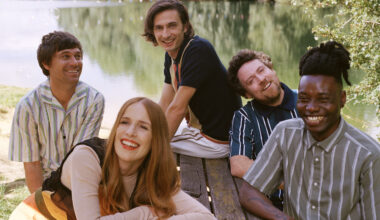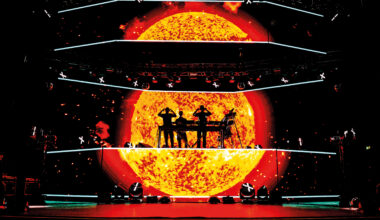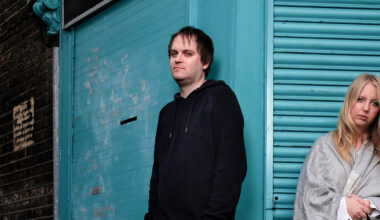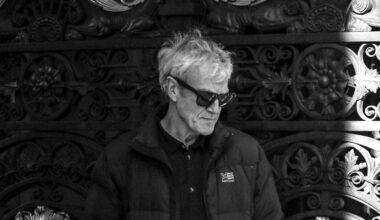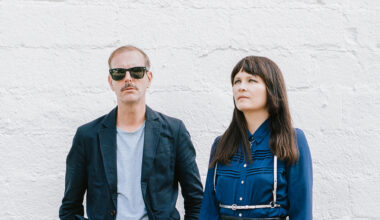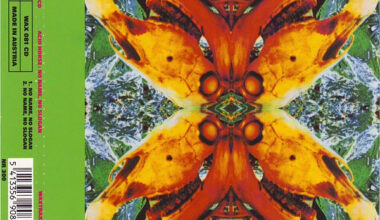The Cinematic Orchestra’s ‘To Believe’ is a love letter to the power of the album. We meet Jason Swinscoe and Dominic Smith to find out why the long-player still matters in an age of streaming and short attention spans…
An apartment in the once bohemian enclave of Fitzrovia is where I meet Jason Swinscoe and Dominic Smith. What brings The Cinematic Orchestra to this swanky area, with such rich associations to literary giants like Virginia Woolf, George Bernard Shaw and George Orwell, on a freakishly balmy February afternoon? Convenience is the disappointing answer. The central London flat overlooking a market has been hired out for the day for promotional purposes, and its interior is empty, but for a guy from Ninja Tune, the two musicians themselves, and boxes upon boxes of albums, which they’ll soon be signing for competition winners.
It’s somehow appropriate that these men and their boxes of records containing multiple versions of their fourth studio album, ‘To Believe’, are all that’s here. The artwork is simple, with the bold uppercase letters CIN – EMA – TIC embossed on the cover and ORC – HES – TRA on the back. There’s no mention of the title on the sleeve other than the title track. It’s almost as if you have to take a leap of faith. The design is minimalistic and powerful. It means business, as do Swinscoe and Smith, dressed mostly in black, who one might suggest are at the sharp end of rediscovering what the album is, and what it’s for, in an age that keeps threatening to leave the format behind forever.
The Cinematic Orchestra emerged in the late 90s as part of the nu jazz scene, making the kind of nocturnal noises that appealed to burnt-out ravers and people who dress like Tom Waits circa 1971. The illustrious jazz roots were strong in 1999’s ‘Motion’, though the tech was more lo-fi, with Swinscoe collecting samples and drum patterns, and layering them over Cubase software on an old Mac Performa 630. In contrast to these humble DIY beginnings, three years later they’d be collaborating with legendary soul singer Fontella Bass; eight years on, they’d perform (and record) a show at the Royal Albert Hall with a 24-piece orchestra, featuring special guests Heidi Vogel and Grey Reverend, who both appear on ‘To Believe’.
The nu jazz element is barely detectable on the new album, while the cinematic aspect is a full 70mm Technicolor. Subterranean beginnings have given way to sold-out shows in prestigious venues across the world, including a recent three-night residency at London’s Roundhouse. What’s more, the Patrick Watson collaboration ‘To Build A Home’ has become famous by stealth as mood music on a raft of popular US dramas. In an interview with the Red Bull Music Academy in 2014, Swinscoe said: “I feel [I’ll be] shackled to that tune for the rest of my life”.
A ‘Late Night Tales’ compilation emerged in 2010 and there was an experimental album of filmic reimaginings in 2012, but then time drifts by. When a new Cinematic Orchestra album finally does appear, it’s notable that there’s been no studio long-player for 12 years. In May 2007, when ‘Ma Fleur’ was released, Tony Blair was in power, and the smartphone revolution had barely begun. So then chaps, why has it taken so long to bring out a new record?
“It takes time to put this kind of music together,” says Swinscoe, without even a hint of a smirk. “It does.”
Okay, well maybe a little smirk.
“Me and Jay working closely together was different to how it was before,” says Smith, who has flown in from his home in Los Angeles this morning and is battling jet lag. “Working from the ground up co-writing was a new thing. There was a period of learning and finding a language between ourselves. I think that LA definitely became part of that new narrative for us.”
The 12 years haven’t all been spent idling. Swinscoe started a family and moved around from city to city: New York, LA, Paris and the slightly less glamorous county of Herefordshire, where he says he resides “for now”. Smith has been in California for most of that time, and it was when his bandmate spent two years there that their musical relationship moved up a gear.
“There was never a feeling of wanting to rush the record,” says Smith, “and always a feeling of wanting to maintain our own connection to what we felt was an honest journey, in trying to create another cinematic moment. We’ve always taken it kinda seriously.”
Naturally, he laughs when he says this.
“It’s never been a commercial venture,” says Swinscoe. “It never was at the beginning and it never will be. It’s more about creating art, and if there’s a 12-year hiatus with the studio recordings, then so be it. The legacy and the seriousness of music creation and production is paramount in putting out another record, as is the songwriting.”
We live in a time where it’s never been easier to make, market and distribute sounds, and so there’s a sense that music itself as a commodity has been devalued by its sheer availability. To hear two grown men talk with such solemnity about their art feels, well, old-fashioned, and maybe even earnest, which is dangerous in an age that demands sangfroid and a sense of irony at all times.
And yet it’s hard to argue with their fastidiousness, and impossible to fault the product. ‘To Believe’ feels like an album that has been meticulously and lovingly assembled, with a beginning, a middle and an end; a complete suite of seven songs designed to be listened to from start to finish with everything in its right place, like a ‘Dark Side Of The Moon’ or Serge Gainsbourg’s ‘Histoire De Melody Nelson’; not so much a concept album as one with a thematic thread delicately binding it together.
It should be pointed out at this point that Swinscoe and Smith are not men devoid of humour – they’re very good company – but that doesn’t disguise the fact they talk about their own music with a sense of gravity that’s unusual these days. Given the significance they place on their material, do they think the art of the album is being lost?
“It is indeed,” says Swinscoe. “Longform is really important, and it was important when Dom and I were growing up. I would want to listen to an album from start to finish uninterrupted. Those great records which took the concept of the full length, the narrative experience, with that immersive quality… you were listening to pure music.”
“I can remember buying albums and thinking, ‘Oh this track is good, but I’m not sure about the rest of it’,” says Smith. “After a while, you begin to understand how everything fits together and why everything is where it is, and maybe it was my lack of understanding at the beginning that didn’t allow me to appreciate all of those things. And then suddenly you can never imagine it without all of its integral parts.”
Obviously this calls for an example. He cites Jon Lucien’s ‘Rashida’, a lush tropical jazz odyssey from 1973 that was given the re-release treatment not so long ago.
“It’s a fucking amazing record, but it divides audiences every time,” he says. “Sometimes it’s a strong drink, musically. It was recommended by a really good friend Jean-Claude [Thompson] who runs If Music, and he was like, ‘You have to have this album’. And I remember taking it home and thinking, ‘Well, there’s one really good track on it’. And then a month later, I was like, ‘Oh my God, that’s a fucking masterpiece’. It’s a beautiful album; amazing production and strings. If you’re a nerd, you’ll love it.”
So is the album format moribund, or is it taking a well-earned nap?
“It just goes out of focus,” says Swinscoe. “The focus has shifted.”
“I totally agree,” says Smith. “I think it being out of focus is a lovely metaphor. It kind of reminds me of the Sly Stone speech at Woodstock where he says, ‘We’re gonna try and do a singalong. A lot of people don’t like to do it because they feel it might be old fashioned. But you must dig that it’s not old fashioned in the first place. It is a feeling. If it was good in the past, then it’s still good’. Great albums become greater every year. ‘Dark Side Of The Moon’ doesn’t get less important, it gets more important. Urban Outfitters will stock all the classic albums, there’s a resurgence of vinyl for God’s sake, and if that’s not a statement of endorsement for the album, then what is?”
There’s a sense of cohesion with ‘To Believe’ that’s clearly no accident, even with so many collaborators. As well as those already mentioned, the record includes turns from Moses Sumney, Dorian Concept, Tawiah and a show-stealing performance by Roots Manuva on ‘A Caged Bird /Imitations Of Life’. I wonder if working on soundtracks in the past helped create the narrative, and in particular I’m thinking about the score The Cinematic Orchestra brought to a screening of Dziga Vertov’s 1929 masterpiece ‘Man With A Movie Camera’.
First screened in Porto in 2001, it was a commission by the EU when the Portuguese city was their European Capital Of Culture. You can still catch The Cinematic Orchestra’s version on YouTube and marvel at how they’ve married up cuts from their second album ‘Every Day’ with Vertov’s busy style, documenting the city in motion. This work of Soviet propaganda is a film school perennial and it’s easy to see why: it’s a bravura work of montage filmmaking where to watch is to disbelieve that it’s 90 years old, especially with a vibrant, contemporary score like that performed by The Cinematic Orchestra.
“There are a few people who’ve done a score for it,” says Swinscoe. “I went to see Michael Nyman do it at the Queen Elizabeth Hall. I think it was just after we’d done it, and I was very curious. The film starts, and we made a very intentional decision that the first four minutes would be silent, but Michael Nyman is straight in with these arpeggios – a totally different perspective on the film.”
Swinscoe admits he had no idea how to score a soundtrack when the invitation came.
“We were working on ‘Every Day’ at the time,” he says, “and we had to figure out what tracks could be appropriated and what else had to be written. And I remember carting this old telly down to the rehearsal room at London Bridge with a VHS player and a broken remote so we could figure out what might work. It was a wonderful experience and it did inform music making on future records.”
As for the title of the new album, what should we believe in this post-truth internet age? How do we maintain any belief system when everything’s so confusing? Or when the algorithms of a website can influence the way in which we vote?
“If we don’t believe, we can’t do anything,” says Smith. “And maybe it’s just a meditation on being human, our consciousness and how we form belief.”
“It’s all very scary, and it requires more attention as humans not to be swept down the funnel of technology and be told this is what you have to believe in,” adds Swinscoe.
“Before, it was easier to believe in the truth, but was it ever there?” says Smith. “I don’t know. Now everyone is asking, ‘What is the truth?’ and that’s actually a really healthy thing. The hope is that maybe we’ll trust each other, and we’ll get through this time of uncertainty and discover what it is we do believe in.”
‘To Believe’ is out on Ninja Tune

